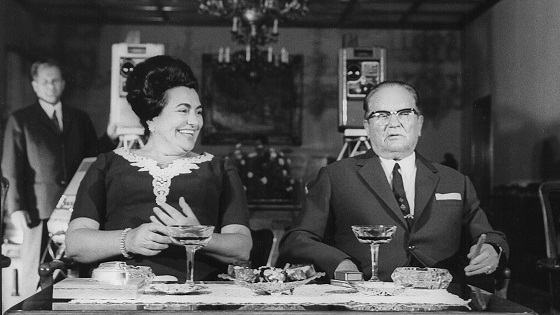
For 32 years, Leka Konstantinovic was the personal film projectionist for Yugoslavian president and noted film enthusiast Josip Broz Tito. Comprised of interviews with Konstantinovic and other important figures in the brief but glowing history of Yugoslavian cinema, as well as archival clips from more than 60 films, Cinema Komunisto is a vibrant, fascinating celebration of a film industry—and a nation—that no longer exists. Cinema Komunisto has its North American premiere in the World Documentary Competition section at the 2011 Tribeca Film Festival.
Interview with director Mila Turajilic
VIMOOZ: What brought you to make a documentary on this subject? Was it something you’d been planning for a long time?
MT: I knew I wanted to make a documentary about the run-down film studios that are rotting in this forest on a hill above Belgrade. Initially I was interested in exploring the place, documenting how it looks today, and interviewing the old film workers who still go there every day to wait out their retirement. I was listening to many of their stories about the golden times, and decided to look for archive about the building of the studios and the big films that were made there, and slowly as I watched the footage from the past and learned about the context of the film studio, I realised it was a great metaphor to tell a much wider story, about a country that was fictional.
VIMOOZ: How long did the film take to make?
MT: It took me 5 years from the initial idea to the finished film, mostly because my research kept revealing new things, and adding layers to the story, like that of Tito’s personal involvement with cinema. I was obsessed with really uncovering everything there was about this topic, and with finding every film that was made in the studios, and this took a long time, because in many cases it was difficult to get access to a certain location where I wanted to film, or to an archive. Also I talked to dozens of people before settling on my characters, and then we filmed 3 to 4 interviews with each one, because in between interviews I was researching archive and watching old films, and polishing the script.
VIMOOZ: How did you begin the script, and decide how to structure the story you were telling?
MT: I started writing the script after interviewing many old film workers– the arch of the story became clearer to me, and I knew where I wanted it to start and end. I knew two things from the outset: that I absolutely did not want to have a narrator, and that I wanted the historical part of the story to end in 1991, at the beginning of the war. Then I began researching archives, and this helped me understand which scenes it would be possible to build, so I was able to refine the script, essentially breaking the story down into chapters. Once I had these ideas for sequences figured out, I started tailoring my interview questions, deciding on the best locations to shoot them, to get the material we needed. Finally I started looking for film scenes that would fill in parts of the story that were missing. The script influenced the research process, but also, the research process and new material I discovered then in turn, affected the script.
VIMOOZ: What was your experience making the film, as it was your first feature?
MT: It was definitely the highest mountain I’ve ever climbed in my life, and there were long stretches where I couldn’t see the end of it at all. My biggest worry was that all this material, and all these layers of themes and pretty abstract ideas wouldn’t come together as a story, but once the scenes starting falling into place in the editing room, I knew we had a film. I realised that having time to do a film properly is almost more valuable than having the money to do it, as a film like this that’s so archive-based really needs time. In terms of production I learned that people ultimately recognize the passion you put into a project, and will go out of there way to help you when they realise how serious you are, so I was lucky to form very important and supportive relationships with my crew but also the characters and people working in the archives.
VIMOOZ: Has the film been released in the former Yugoslavia? If so, what was the reception like?
MT: The film was shown in Serbia and recently in Slovenia. In Serbia the reaction was so overwhelming that the next day we were booked into several multiplex cinemas, which has never happened to a documentary in Serbia. The most amazing thing for me was the fact that young people told me that they were going to see it with their parents, and that was so special, to see the film sparking a conversation between generations, because the young people were then asking their parents questions after the film about all the things they’d see in it. It also contributed to an ongoing debate taking place in our media about this renewed interest in Tito’s Yugoslavia, and I’ve had many comments from people that they found it such a refreshing addition to what has often been a topic that’s very heatedly discussed. We are still finalising our plans for the film’s premieres in Bosnia and Croatia and I’m really looking forward to seeing the audience’s reaction.
VIMOOZ: Have the subjects of the film seen it (those you interviewed)? What did they think?
MT: The only character who insisted on seeing the film before it was shown publicly was Veljko Bulajic. His reputation as Tito’s favorite film director made him quite controversial over the years, so he is slightly more careful about how he is portrayed. Ironically enough, the cinema in which I screened the film for him was the old screening room of the censorship committee during communism. He was very impressed by the film and all the work that had gone into it, so he didn’t have any big criticism. The other characters saw the film at the premiere, and I think were blown away by what we had achieved and also by the intensity of the reaction of the audience– so it was a very special moment for all of us together. The saddest part is that Tito’s projectionist didn’t live to see the film, he died a month before our premiere.
VIMOOZ: How do you feel about your film being at Tribeca?
MT: Its very exciting, because no Serbian documentary has ever been presented in America at that level, so I think we’re also in a way bringing attention to our part of the world, and showing what’s going on in Serbia in terms of quality of production. I’m really looking forward to a chance to present the film to US audiences and to get feedback on how they see the whole story, and which parts of it they will react to. Tribeca is so well known around the world, that the reaction in Serbia to our acceptance at Tribeca has been amazing, it’s been reported on the evening news.
VIMOOZ: How has your experience been showing the film at other festivals?
MT: I welcome every chance to talk to the audience after the screening, because the film opens so many questions, both about the past and the present situation in Serbia. Also, after 5 years of working on it, there is so much that we gathered and couldn’t put in the film that people always like to hear about that. I’ve promised we will put some of the deleted scenes on the DVD.
VIMOOZ: Has it been difficult getting distribution in the US? Will it be released in theaters?
MT: The unexpected success we had in Serbia, with the theatrical release, has definitely indicated that we have a film with theatrical potential. We’re setting up meetings at Tribeca to see what kind of distribution we can arrange for the US.
VIMOOZ: What is your next project?
MT: I’m working on a documentary that I’ve been filming for the last few years, it covers the story of Serbia in the 90s, up until the present day, but again from a different angle, this time not through cinema, but through a keyhole.


Leave a Reply
You must be logged in to post a comment.